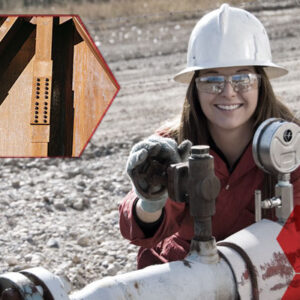Introduction

The Cathodic Protection (CP) industry plays a pivotal role in safeguarding critical infrastructure from corrosion-induced deterioration. Understanding the principles, types, components, applications, and recent advancements in this field is vital for ensuring the longevity and integrity of diverse structures. This blog delves into the world of cathodic protection, exploring its evolution and its impactful applications across various sectors.
Principles of Cathodic Protection

Cathodic protection is a crucial technique used to prevent and mitigate corrosion in various metallic structures. This electrochemical process works on the principle of controlling the corrosion of a metal surface by making it the cathode of an electrochemical cell. The underlying principles involve understanding the electrochemical processes and corrosion mechanisms, as well as how cathodic protection effectively counteracts corrosion.
Electrochemical processes involved in cathodic protection
Electrochemical processes play a fundamental role in cathodic protection. When a metallic structure is exposed to an electrolyte (typically soil or water), it forms an electrochemical cell. The cell consists of an anode, where oxidation occurs, and a cathode, where reduction takes place. In cathodic protection, the structure to be protected is intentionally made the cathode.
The electrochemical reactions at the cathode involve the reduction of oxygen or other oxidizing species present in the electrolyte. This reduction reaction consumes electrons and prevents the oxidation of the metal at the anode (the structure being protected). By providing a source of electrons (usually through an external power supply or sacrificial anodes), the structure maintains a negative potential, effectively becoming the cathode and thus preventing corrosion.
Corrosion mechanisms and how cathodic protection mitigates them

Corrosion is a natural process where metals deteriorate due to chemical or electrochemical reactions with their environment. The most common form of corrosion is electrochemical corrosion, where metals react with oxygen or other corrosive agents.
In this context, cathodic protection serves as a mitigation technique by altering the electrochemical reactions involved in corrosion. Traditional corrosion occurs due to anodic reactions (oxidation), where metal atoms lose electrons and deteriorate. Cathodic protection shifts the focus to the cathodic reactions (reduction), where electrons are gained, preventing the metal from oxidizing.
By forcing the protected structure to become the cathode, the reduction reactions take place at its surface instead of oxidation. Electrons are supplied to the cathode, typically from a sacrificial anode or an external power source, which ensures that the protected metal remains in a reduced state, preventing its corrosion. This shift in electrochemical behavior significantly prolongs the lifespan and structural integrity of the protected metal.
Types of Cathodic Protection Systems

Cathodic protection (CP) is a technique used to prevent corrosion of metal structures and equipment by controlling the electrochemical reactions that cause corrosion. It involves making the metal structure the cathode of an electrochemical cell, thereby protecting it from corrosion. In this context, advancements and applications in the cathodic protection industry have led to the development of various types of cathodic protection systems. Two primary types are impressed current cathodic protection (ICCP) systems and sacrificial anode cathodic protection systems.
Impressed Current Cathodic Protection (ICCP) Systems
Impressed current cathodic protection (ICCP) systems are a sophisticated and widely utilized form of cathodic protection. These systems involve an external power source that provides a continuous direct current to the structure to be protected. The power source is typically a rectifier that converts alternating current (AC) to direct current (DC). The DC current is passed through insoluble anodes (usually made of materials like graphite, mixed metal oxide, or platinum-coated titanium) and into the electrolyte surrounding the metal structure, creating a protective electrochemical environment.
Sacrificial Anode Cathodic Protection Systems
Sacrificial anode cathodic protection systems involve using a more reactive metal, termed a sacrificial anode, which is attached to the structure to be protected. This sacrificial anode corrodes preferentially, supplying electrons to the structure and preventing corrosion.
Key Components of Cathodic Protection Systems

Cathodic protection is a crucial technique used to prevent corrosion of metallic structures and infrastructure. It involves the use of a sacrificial anode or an impressed current to protect the metal from corroding. In this discussion, we will elaborate on the key components of cathodic protection systems, focusing on anodes and their materials, rectifiers and power sources for impressed current systems, and monitoring and control systems.
Anodes and Their Materials
Anodes are a fundamental component of cathodic protection systems. They are electrodes that release electrons to the structure being protected, thereby preventing the structure from corroding. There are two main types of anodes: sacrificial anodes and impressed current anodes.
- Sacrificial Anodes:
Sacrificial anodes are made of metals or alloys that have a more negative electrochemical potential than the structure they are protecting. Common sacrificial anode materials include zinc, aluminum, and magnesium. These anodes corrode over time, sacrificing themselves to protect the structure.
- Impressed Current Anodes:
Impressed current anodes are typically inert and stable materials such as graphite, mixed metal oxide (MMO) coated titanium, or platinum. These anodes are connected to an external power source (rectifier) and release electrons into the surrounding environment to protect the structure. The MMO coating improves anode efficiency and extends its lifespan.
Rectifiers and Power Sources for Impressed Current Systems

Rectifiers and power sources are critical to cathodic protection systems that use impressed current. These components provide the necessary electrical power to drive the cathodic protection process.
- Rectifiers:
Rectifiers convert alternating current (AC) to direct current (DC), which is essential for impressed current cathodic protection. They regulate the DC output to ensure a consistent and controlled current flow to the anodes, enabling effective corrosion prevention.
- Power Sources:
Power sources can include transformers, generators, solar panels, or batteries. They supply the input power to the rectifiers, which then convert and deliver the appropriate DC voltage and current to the impressed current anodes for corrosion protection.
Monitoring and Control Systems

Monitoring and control systems are essential for ensuring the effectiveness and efficiency of the cathodic protection system.
- Monitoring Systems:
These systems continuously monitor parameters such as potential difference, current output, and anode condition. Advanced monitoring technologies provide real-time data, allowing for proactive adjustments and immediate response to any deviations or issues.
- Control Systems:
Control systems manage the operation of the cathodic protection system based on the data collected by monitoring systems. They can adjust the voltage and current output to optimize protection, reduce energy consumption, and extend the life of the anodes.
Applications of Cathodic Protection

Cathodic protection is a vital technique employed in various industries to prevent corrosion of metal surfaces and structures. By applying an electric current to protect metal from corrosion, this method has found significant applications in diverse sectors. The following are the detailed explanations of its applications in various industries:
Oil and Gas Industry
Cathodic protection plays a crucial role in the oil and gas industry to mitigate corrosion of metallic structures like pipelines, storage tanks, and well casings. Pipelines, which are an essential component of the oil and gas infrastructure, are often buried underground or submerged, making them susceptible to corrosion due to soil or water. Cathodic protection systems are used to ensure the longevity and integrity of these pipelines, reducing maintenance costs and preventing environmental damage caused by leakages.
Water and Wastewater Infrastructure
In the realm of water and wastewater infrastructure, cathodic protection is utilized to safeguard various assets such as water tanks, pipelines, and wastewater treatment facilities. Water tanks made of steel, for instance, are protected using cathodic protection to prevent rust and maintain the structural integrity of the tanks. Additionally, wastewater treatment plants employ cathodic protection to enhance the durability of metal components exposed to corrosive environments.
Transportation Infrastructure

Transportation infrastructure, including bridges, pipelines, and ports, often endure harsh environmental conditions. Bridges, especially those over water bodies, are exposed to high levels of humidity and saline air, making them susceptible to corrosion. Cathodic protection systems are applied to protect these structures and extend their operational life. Similarly, pipelines that traverse diverse terrains and ports dealing with marine environments implement cathodic protection to combat the corrosive effects of the surroundings.
Marine Structures
Marine structures are constantly exposed to corrosive seawater, necessitating the application of cathodic protection to prevent deterioration. Piers, docks, and ships, all made predominantly of metal, are protected using sacrificial anodes or impressed current systems. Sacrificial anodes corrode sacrificially, diverting the corrosion away from the structure they protect. On the other hand, impressed current systems utilize a power source to drive the cathodic protection, ensuring an efficient and lasting solution against corrosion in a marine environment.
Advancements in Cathodic Protection

Innovations in Materials and Coatings for Anode
Recent advancements in cathodic protection technology have been significantly influenced by innovations in anode materials and coatings. Anodes are a crucial component of cathodic protection systems, as they facilitate the controlled corrosion of the anode instead of the protected structure. Innovations in anode materials have focused on improving efficiency, longevity, and cost-effectiveness.
- Advanced Anode Materials
New materials, such as mixed-metal oxide (MMO) anodes, have gained popularity due to their excellent electrochemical properties. MMO anodes exhibit high conductivity, low consumption rates, and resistance to harsh environments. These advancements have resulted in more efficient corrosion prevention and longer-lasting protection for structures.
- Coating Technologies
Innovations in coatings for anodes have addressed challenges related to adhesion, chemical resistance, and durability. Improved coatings, like ceramic and polymer coatings, offer enhanced protection against aggressive corrosive environments. These coatings ensure the anode’s longevity and stability, optimizing the overall cathodic protection system.
- Nanotechnology Applications
Nanotechnology is being leveraged to develop nanostructured anode materials with enhanced properties. Nanostructured materials possess a high surface area, allowing for better electrochemical reactions and corrosion resistance. Integrating nanotechnology in anode materials contributes to improved efficiency and performance of cathodic protection systems.
Remote Monitoring and Control Technologies

The advent of remote monitoring and control technologies has revolutionized the management of cathodic protection systems. These technologies provide real-time monitoring and control capabilities, offering numerous benefits in terms of efficiency, accuracy, and cost-effectiveness.
- Real-Time Monitoring
Remote monitoring systems enable real-time data collection on the performance of cathodic protection systems. Parameters such as current density, potential, and environmental conditions are continuously monitored and analyzed. This real-time data allows for proactive decision-making and timely adjustments to optimize the protection provided.
- Automated Control Systems
Integration with automated control systems allows for precise adjustment of cathodic protection parameters based on the monitored data. Automated adjustments ensure that the system is operating optimally, reducing the need for manual intervention and minimizing human error. This enhances the overall efficiency and effectiveness of corrosion prevention.
- Predictive Maintenance
Remote monitoring technologies also facilitate predictive maintenance by analyzing system data to predict potential issues or maintenance requirements. This proactive approach to maintenance helps in preventing system failures, reducing downtime, and ultimately cutting maintenance costs.
Integration of Cathodic Protection with IoT and Data Analytics

The integration of cathodic protection systems with the Internet of Things (IoT) and data analytics has introduced a new dimension to corrosion prevention. This integration leverages the power of data to enhance the efficiency, reliability, and sustainability of cathodic protection systems.
- Data-Driven Insights
IoT-enabled cathodic protection systems generate vast amounts of data regarding system performance, environmental conditions, and corrosion rates. Data analytics tools process and analyze this data, providing valuable insights into the system’s health and performance trends. These insights enable informed decision-making for optimizing the protection provided.
- Predictive Modeling
Data analytics can be used to develop predictive models that forecast future corrosion rates based on historical data and environmental factors. Predictive modeling helps in designing proactive strategies to enhance protection and extend the life of structures, ultimately saving costs associated with maintenance and repairs.
- Enhanced Decision-Making
By integrating cathodic protection with data analytics, stakeholders can make data-driven decisions to optimize system performance, prioritize maintenance activities, and allocate resources effectively. This integration ensures a proactive and efficient approach to cathodic protection, aligning with industry best practices and sustainability goals.
Conclusion

In conclusion, the Cathodic Protection industry plays a critical role in safeguarding vital infrastructure from corrosion, ensuring longevity and efficiency. Employing cathodic protection techniques is essential for mitigating corrosion-related risks and minimizing maintenance costs. To deepen knowledge and expertise in this field, professionals and enthusiasts can benefit from specialized courses offered by the CORCON Institute of Corrosion.
These courses provide valuable insights, advanced methodologies, and practical skills needed to excel in the ever-evolving world of cathodic protection, making them a valuable resource for anyone involved in the industry. Investing in education and staying updated with industry advancements through CORCON’s courses can enhance the overall competence and effectiveness of professionals in the Cathodic Protection industry.
Image Reference: Freepik
Disclaimer: All trademarks, logos, and brand names are the property of their respective owners. All company, product, and service names used in this website are for identification purposes only. Use of these names, trademarks, and brands does not imply endorsement.

